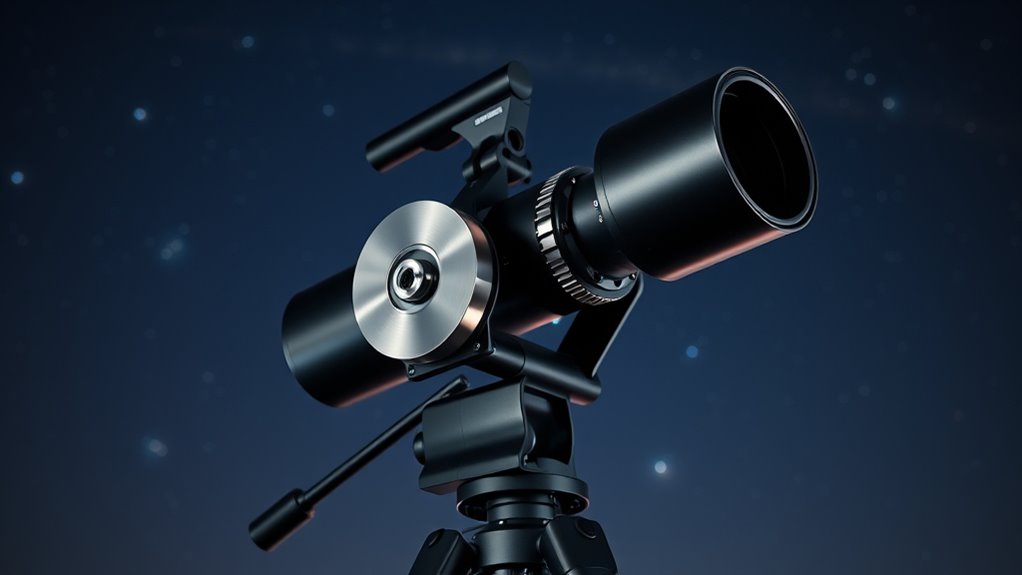Based on my research, the iEXOS-100-2 PMC-Eight Equatorial Tracker System stands out as the top choice for precision astrophotography. It features an advanced belt drive system that offers smooth, quiet operation, reducing vibrations and increasing accuracy. Its compatibility with various mounts and software, combined with reliable power needs and excellent stability, makes it ideal for detailed imaging sessions. Stick around, and you’ll discover more about how this mount can elevate your astrophotography skills.
Key Takeaways
- Look for mounts with high-quality, low-noise belt drive systems for smooth, vibration-free long exposures.
- Ensure compatibility with your telescope’s size, weight capacity, and mounting interface for optimal performance.
- Choose mounts with reliable firmware, software control, and stable connectivity for precise tracking and guiding.
- Prioritize lightweight, portable designs with sufficient load capacity for ease of transport and stable astrophotography sessions.
- Opt for mounts with robust power options and adjustable belt tension to maintain accuracy during extended imaging periods.
iEXOS-100-2 PMC-Eight Equatorial Tracker System for Astrophotography
The iEXOS-100-2 PMC-Eight Equatorial Tracker System is an excellent choice for amateur astrophotographers seeking a lightweight, portable mount with advanced control features. Its design incorporates eight independent CPUs for fast, reliable responsiveness, making star alignment and tracking smooth and efficient. The quiet belt-driven stepper motors and dual-axis worm gears provide precise motion control, while the intuitive ExploreStars app simplifies operation. Despite some limitations with tripod sturdiness and GoTo accuracy, it’s easy to assemble and compatible with lightweight telescopes and cameras. Overall, it offers a budget-friendly, portable solution with solid features for those ready to explore astrophotography.
Best For: amateur astrophotographers seeking a lightweight, portable, and budget-friendly equatorial mount with advanced control features for night sky imaging.
Pros:
- Lightweight and portable design ideal for mobile setups
- Incorporates eight independent CPUs for fast, responsive operation
- Quiet belt-driven motors and dual-axis worm gears for precise tracking
Cons:
- Tripod legs may lack sturdiness, requiring adjustments or reinforcement
- GoTo accuracy can be inconsistent without proper calibration and optional azimuth plates
- Connectivity and software control can be finicky, with limited Bluetooth support out of the box
Factors to Consider When Choosing Equatorial Mounts With Belt Drive Systems

When selecting an equatorial mount with a belt drive system, I consider several key factors to guarantee excellent performance. These include how efficient the belt drive is, whether the mount is compatible with my equipment, and how portable it is for travel. Additionally, I pay attention to motor noise levels and power requirements to keep my astrophotography setup smooth and reliable.
Belt Drive Efficiency
Choosing an equatorial mount with a belt drive system requires careful consideration of factors that directly influence its effectiveness. The quality and tension of the belt are critical, as they affect tracking accuracy and power transfer. A high-quality belt minimizes backlash and gear slop, leading to more precise celestial tracking. Proper belt tensioning and pulley size also play essential roles; they determine how responsive and energy-efficient the mount is. Belt drives generally provide smoother, quieter operation, which reduces vibrations that can disturb astrophotography. Additionally, well-designed systems tend to experience less wear over time, requiring less maintenance and ensuring consistent performance. Overall, focusing on these factors helps ensure you select a belt drive system that delivers effective efficiency for long, detailed astrophotography sessions.
Mount Compatibility Options
Selecting an equatorial mount with a belt drive system means ensuring it fits seamlessly with your astrophotography equipment. Compatibility options include matching telescope diameters, weight capacities, and mounting interfaces like Vixen, Losmandy, or Celestron, which help accommodate various setups. Belt drive mounts require appropriate motor sizes and gear ratios to deliver smooth, precise tracking, so verifying these specs is essential. Additionally, consider software compatibility and firmware update availability, as these influence how well the mount integrates with control systems or remote operation tools. Power requirements are also critical, especially if you plan on portable setups, and connectivity with guiding cameras or star trackers should be straightforward. Ensuring these compatibility factors align with your gear will optimize performance and simplify your astrophotography experience.
Weight and Portability
Lighter equatorial mounts with belt drive systems are highly desirable for astrophotographers who often work in the field, as they make setup quicker and less physically demanding. Their portability allows for easier transportation and quick deployment, saving valuable observing time. These mounts are typically more compact, making them ideal for those with limited storage space. However, it’s essential to guarantee that the mount’s load capacity matches your telescope and accessories; inadequate capacity can compromise tracking accuracy. While lightweight designs improve portability, they should still offer sufficient rigidity to maintain stability during imaging sessions. Striking the right balance between weight and sturdiness ensures you get a setup that’s both easy to carry and capable of delivering precise, stable tracking for high-quality astrophotography.
Motor Noise Levels
Since belt drive systems generally operate more smoothly than gear-based counterparts, they tend to produce less noise during astrophotography sessions. Typically, belt drives produce sound levels around 20-30 dB, making them markedly quieter than traditional gear systems. This reduced noise helps minimize vibrations and disturbances that could compromise image quality. The choice of belt material and proper tensioning also impacts noise levels; high-quality, well-maintained belts tend to be much quieter. Additionally, motor noise varies with the mount’s speed and load, with lower speed tracking producing even less sound. Overall, quieter belt drives enhance the astrophotography experience by maintaining stability and preventing sound-induced vibrations, which are critical for capturing sharp, clear images through long exposures.
Power Supply Needs
Have you considered how your power supply impacts the performance of belt drive equatorial mounts? A stable, reliable power source is vital to prevent intermittent tracking errors and guarantee smooth motor operation. Many mounts need dedicated external power sources, like lithium batteries or AC adapters, that can deliver sufficient current for precise movements. Inadequate or fluctuating power can lead to belt slippage, misalignment, or motor stalls, which directly affect astrophotography accuracy. Using underpowered batteries or unstable supplies means frequent recharges or replacements during long sessions, interrupting your imaging. Proper power management—including voltage regulation and backup options—boosts reliability and extends the lifespan of your mount. Investing in a quality power supply is essential for consistent performance and high-quality results.
Precision and Stability
The way a belt drive system is tuned and constructed directly impacts the tracking accuracy and overall stability of an equatorial mount. Precise tension and proper alignment of the belts are crucial—any slack or misalignment can cause tracking errors. High-quality belts with accurate timing belts and pulleys reduce vibrations, ensuring smoother movements during astrophotography sessions. Minimizing backlash and periodic error enhances the mount’s ability to follow celestial objects accurately over long exposures. Proper calibration of the belt drive system is essential for maintaining consistent precision. Additionally, the mount’s structural rigidity plays a vital role in resisting external disturbances. Combining well-tuned belt drive mechanics with a sturdy frame ensures reliable stability, leading to sharper images and more successful astrophotography sessions.
Software Integration Features
Choosing an equatorial mount with strong software integration can make a significant difference in your astrophotography experience. It allows for seamless control, automation, and calibration, which are essential for efficient sessions. Compatibility with popular software like ASCOM, INDI, and third-party apps enhances flexibility and expands functionality. Belt drive systems often support advanced features such as precise tracking, guiding corrections, and automated object slewing, all managed through integrated software. Firmware updates and open-source control options also enable customization, troubleshooting, and ongoing performance improvements. Reliable connectivity—via stable WiFi or USB—minimizes disconnections and ensures real-time, accurate mount control. Overall, robust software integration simplifies complex tasks, boosts accuracy, and elevates your astrophotography results.
Frequently Asked Questions
How Do Belt Drives Impact Mount Vibration Damping?
Belt drives considerably improve mount vibration damping by providing smoother, more consistent motion. I’ve noticed that with belt drives, vibrations settle faster after adjustments, thanks to their lower backlash and reduced gear noise. This stability helps me capture sharper images, especially during long exposures. Overall, belt drives make my astrophotography sessions more precise and enjoyable, giving me confidence that vibrations won’t ruin my shots.
Can Belt Drive Mounts Support Heavy Astrophotography Equipment?
Yes, belt drive mounts can support heavy astrophotography equipment, but it depends on the mount’s specifications and build quality. I always check the weight capacity and guarantee the mount’s motors and structure are robust enough for my gear. When properly rated, belt drives provide smooth, precise tracking even with heavier setups, helping me capture clear, sharp images without sacrificing stability or accuracy.
Are Belt Drive Systems Suitable for Portable Astrophotography Setups?
Absolutely, belt drive systems are perfect for portable astrophotography setups. They’re like the secret sauce that keeps your gear smooth and steady on the go. Lightweight and compact, they don’t weigh you down, making setup a breeze. Plus, they cut down on vibrations and noise, so your images stay sharp. If you want reliable, high-precision tracking while traveling, belt drives are a game-changer for portable astro adventures.
How Maintenance-Intensive Are Belt Drive Equatorial Mounts?
Belt drive equatorial mounts aren’t too maintenance-intensive if you keep them clean and well-lubricated. I regularly check the belts for wear and tension, and I clean the gears to prevent dust buildup. Usually, a quick inspection every few months suffices. They’re pretty reliable once set up properly, and with minimal upkeep, you can enjoy precise astrophotography without worrying about frequent repairs.
What Is the Typical Lifespan of Belt Drive Components in Mounts?
A stitch in time saves nine, and I find that belt drive components in mounts typically last between 5 to 10 years with proper care. Regular maintenance, avoiding excessive stress, and using quality belts can extend their lifespan. I’ve seen users enjoy many years of precise tracking before replacements become necessary. Keep an eye on belt condition, and you’ll get the most out of your mount’s lifespan.
Conclusion
Choosing the right equatorial mount with a belt drive system can truly transform your astrophotography. With options like the iEXOS-100-2 PMC-Eight, you get precision, quiet operation, and seamless software integration. But aren’t we all aiming for those perfect, sharp images that capture the cosmos’ beauty? Investing in the best system tailored to your needs guarantees you’ll enjoy countless nights of stunning astrophotos—making your celestial dreams a reality.









